Auxiliary Notes
Auxiliary notes are non-chord notes which are approached and quit in the opposite direction by step. They are usually unaccented. They can either be upper or lower auxiliary notes.

Version A is undecorated. Version B uses an upper auxiliary note between the two alto Gs; version C uses a lower auxiliary note.
Auxiliary notes are normally used for a specific reason – either to improve the melody, or to improve the harmony. Be careful not to add auxiliary notes to your music which don’t add anything of interest at all!
One common purpose for auxiliaries is to liven up a melody line, by creating a more interesting rhythm or melodic pattern.
Here is an undecorated piano excerpt:

Adding decoration makes the tune more appealing, because it is no longer just a simple descending scale.

Another common purpose of auxiliary notes is to make a more interesting harmony by creating new chords between the beats, (often this happens in conjunction with passing notes in other parts).
In Chorale 96, the alto C# creates a new chord of vii°7. In situations like this, the auxiliary note is not dissonant, and this could alternatively be analysed as an auxiliary chord.
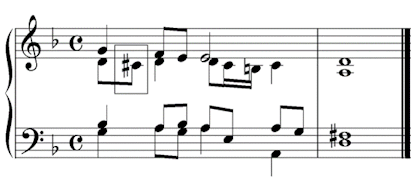
The auxiliary note in the bass here in Chorale no.200, helps to keep up the rhythmic momentum between two identical bass notes, providing a tuneful bass line while nothing else is happening.
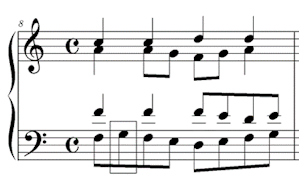
Caution! Auxiliary notes are actually very rare in Bach chorales and most chorales contain none. If you are writing harmony in the style of a Bach chorale, it is better to keep auxiliary notes to the absolute minimum.
Things to look out for when writing auxiliary notes:
- Avoid augmented and diminished melodic intervals,
- Check for consecutive 5ths and octaves,
- Raise the leading note in a minor key.
Examples: the key is A minor. An auxiliary note F will make an interval of an augmented 2nd. To avoid this, we sharpen the F.

The addition of an upper auxiliary G here creates consecutive 5ths – this isn’t allowed.
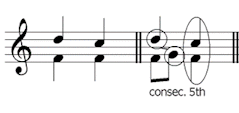
Auxiliary Harmony Notes
Auxiliary harmony notes are decorative chord notes which belong to the current chord. They can be accented or unaccented.
In this example, the alto and bass notes in the first box are auxiliary harmony notes, and so are the soprano D and alto F# in the second box.
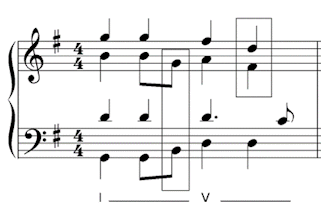
Auxiliary harmony notes often move in pairs like this, so that the correct doubling and voicing of the chord can be maintained. In the first case, if only the alto part moved, the chord would be missing its third (B), and if only the bass moved, the chord would have a doubled third. Moving both parts allows a better voicing of the chord with one third and a doubled root, on this quaver (8th note).
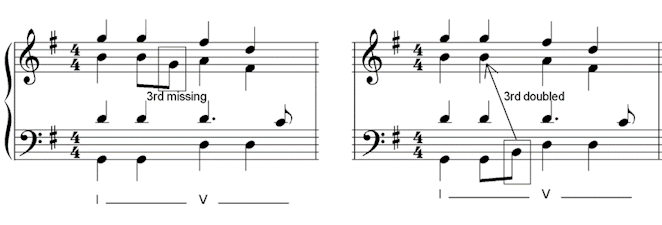
Be careful when using the 5th of the triad as an auxiliary harmony note, because you may inadvertently create a second inversion chord which is not in a suitable place.
In the first box here, the 5th of the G major triad (D) works as an auxiliary harmony note, because it returns to G. It can be considered as an auxiliary 6/4. In the second box, the 5th of the D major triad (A) does not work as an auxiliary harmony note, because it creates a second inversion chord which is in an unsuitable place.

The normal advice regarding voice leading applies when you are adding auxiliary harmony notes. Larger leaps of a 4th, 5th or octave are normally only found in the bass part. Smaller leaps of a third are acceptable any of the parts, but should be kept to a minimum in the inner harmony parts, as these tend to move as smoothly as possible.
Appoggiaturas
The appoggiatura is both an ornament and a decoration. The appoggiatura ornament was covered at grade 6, but essentially, the ornament and decoration are the same thing. The more modern method is to write out the appoggiatura in normal sized notes of the correct duration, but this can in turn make the harmony more difficult to decipher. It is an accented dissonance which resolves by step.
Here is an example. In bar 10 of Beethoven’s Sonatina in G, Romanza, the chord may be difficult to spot at first glance. The prevailing key is D major. The right-hand fits a chord of D major, with G and E as unaccented passing notes, but the left-hand does not.

In fact, the chord is E minor (ii). The A is an appoggiatura, resolving by step to chord note G, and the F# and D are passing notes. Tip: look at the lower parts to work out the chord.
Some theory sources say that an appoggiatura must be approached by a leap, and not a step. This differentiates it from the accented passing note. For most UK exam boards, this difference doesn’t matter, and both can be considered as appoggiaturas.
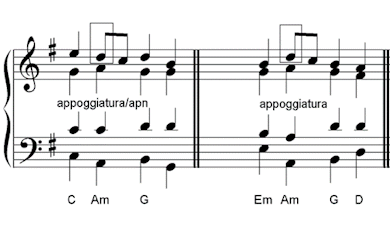
Single, double or triple appoggiaturas are quite common at Classical style cadences.
This example is taken from the end of the second movement of Mozart’s Piano Sonata in Bb K333. This movement is in Eb major. In bars 80-81 we find a perfect cadence (Bb-Eb in the bass) with a double appoggiatura in the right-hand (F and Ab, resolving to Eb and G). The cadence is then repeated in bars 81-82, this time with a triple appoggiatura (Ab, F and D, resolving to G and Eb).
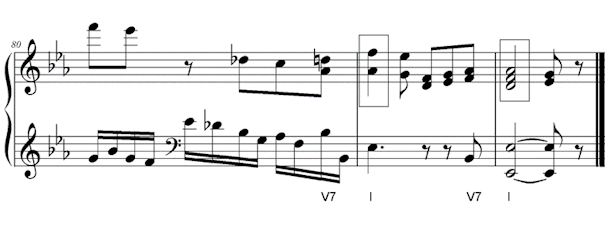
Chromatic Appoggiaturas
Chromatic appoggiaturas are appoggiatura notes which do not belong to the prevailing key.
When you are analysing harmony, chromatic appoggiaturas can often cause confusion. In this melody for example, the A# in bar 2 may lead you to think that the music is perhaps modulating to B minor, but this is not the case. The A# is a chromatic appoggiatura, as is the C# in bar 4. The whole of the melody is in G major, harmonised with just the tonic and dominant chords.

How can we tell whether the A# is a chromatic appoggiatura or modulation note? The answer lies in “what happens next?”
If the music had modulated to B minor in bar 2, we would expect that the melody would continue in the new key for a while, or perhaps would even move on to a third key, if B minor was a “passing through” key. We would not expect the music to return immediately to G major, which is what it does. (It’s also worth considering whereabouts in the piece you are – modulations are unlikely to happen with a few seconds of the opening notes, but are much more common towards the middle of a piece).
Compare this extract, taken from later in this piece. The opening section is the same, but this time the A# is modulation note, not a chromatic appoggiatura. We can tell this, because the implied harmony at the end of bar 34 is a chord of B minor, with V of B minor appearing in bar 35. The music then modulates again, this time to E minor.
